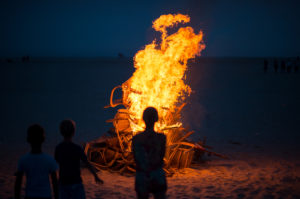 “It is an absolute human certainty that no one can know his own beauty or perceive a sense of his own worth until it has been reflected back to him in the mirror of another loving, caring human being.” —John Joseph Powell, The Secret of Staying in Love
“It is an absolute human certainty that no one can know his own beauty or perceive a sense of his own worth until it has been reflected back to him in the mirror of another loving, caring human being.” —John Joseph Powell, The Secret of Staying in Love
“Invisible threads are the strongest ties.” —Friedrich Nietzsche
There’s a lot more to trauma than meets the eye—or the general public’s awareness—and it’s deeply related to love and connection.
When many people think of trauma, they tend to think about shock trauma: a single, overwhelming incident that’s larger than our ability to cope. Examples include natural disasters, motor vehicle accidents, sexual assault, animal attacks, and war.
On the other hand, developmental trauma comes from something that happens improperly during childhood. It is often subtle and may happen over a long period of time. It involves not receiving the necessary supports for the young nervous system to mature and develop in the way it needs to. Some of these supports are material, of course, but many are relational: having to do with the overall quality and nuances of important relationships, especially with parents.
You can think of it like incorrect or missing ingredients in a recipe: The cake is baked, but it hasn’t risen all the way. Of course, a cake is pretty much finished after it comes out of the oven. The good news for us is, unlike the cake, our nervous system is always primed and waiting to recover what it needs. Thanks to neuroplasticity, our growth and development are lifelong.
In developmental trauma, the biggest and most common missing “ingredient,” by far, is that of deeply and consistently feeling love and connection. I’m not talking about watching your parents behave toward you in a responsible and self-sacrificing manner and then deducing they must love you. No, I’m talking about feeling it deep in your bones that you are loved—indeed, treasured. This bodily felt sense allows us to sink into a sense of safety and well-being. It is truly traumatic to not receive this basic ingredient; we need it to develop and maintain a stable sense of ourselves and of safety.
With love being so basic, how is it so many of us end up without enough of it?
It’s been my experience that:
- Some parents deeply love their kids, but they don’t know how to show (embody) it because they never had this from their own parents.
- Some parents love their kids, but their own life circumstances are too chaotic for them to embody it or be consistent about it with their children. This happens frequently when addiction or other chronic conditions strike the family.
- Some parents simply don’t have the capacity to love, usually due to their own developmental traumas.
- Some people don’t have parents who are in their lives.
Long the fodder of songwriters and poets, our desire for love also has a deeply biological basis. It goes beyond simple reproduction (which is accomplished in reptiles without a shred of sentimentality, as far as we can discern). Basically, the physical origin of love lies in our mammalian biology. We are not lizards! Think about our fellow mammals: puppies, rabbits, hamsters. They are warm and cuddly, and many, if not most, of them prefer company.
As Dr. Stephen Porges explains, reptiles have slow metabolisms; that’s why they are cold, and why snakes can go weeks without eating. Mammals have much faster metabolisms, so we need to eat more frequently. This need to extract more nutrients from the environment requires a more complex survival strategy—and that’s why most of us tend to stick together. It is part of our most essential survival wiring to stick together and form deep, satisfying bonds with other humans.
For us humans, being (or feeling) alone is biologically stressful, and may lead to poor health outcomes including earlier death. Consider:
- In prison settings, solitary confinement is often considered to be a form of torture. Too much of it can cause the person to become psychotic.
- The Atlantic has a series of articles about isolation and loneliness. Research indicates people, animals, insects, and even cells experience health issues and die more quickly in isolation.
- Dr. Dean Ornish is a cardiologist in San Francisco. He has a reputation for being able to save heart patients whom other physicians have been unable to help. He considers his patient support groups an essential part of his formula for success.
- Check your experience: Try to recall the last time you were pleasantly touched by another human being in a way that felt both safe and consensual. If you are unable to access such a memory and you’re an animal lover, you could recall cuddling with a dog or a cat. How did this experience make you feel in your body? Many people report a pleasant sense of warmth, full embodiment, and well-being. Such experiences are accompanied by physiological markers of reduced stress, such as lowered heart rate, blood pressure, and cortisol.
Despite the growing body of literature to the contrary, some people convince themselves they’re okay alone or mostly alone. Some even feel they’re better off that way. Others make do with surface-level interactions, but they don’t share any of their private or intimate feelings very often. Men especially tend to be socialized into the idea it’s not okay to share their deeper feelings (this idea tends to cause them great suffering, which they then have to disconnect themselves from).
In my experience, the reason some folks teach themselves to “make do” with relational crumbs is because they have experienced unbearable pain in their attachment relationships. Such experiences create an unsolvable bind: the person must deny themselves this vital “nutrient” in order to survive. Being alone might be lonely, but at least it feels safe. And so they bury the deep need for love and connection, or they find bits of it by caretaking others and then fleeing when the relationship becomes too intense. However, as Jeremy McAllister notes in his brilliant article Ending the Anxious Avoidant Dance, Part 1: Opposing Attachment Styles, “The most avoidant among us, while perhaps giving up on the possibility (or dissociating from it most of the time), still desire connection outside of self.” It’s in there, somewhere, behind those seemingly impenetrable defenses.
This strategy of forging a life mostly or entirely by oneself often requires some kind of addiction in order to stay disconnected from these intolerable feelings. Common examples include addiction to work, sex, various mood-altering substances, and physical exercise. None of these activities are inherently bad, of course; it all depends on how one approaches them.
The corollary to “love is dangerous” is often “and I’m not allowed to have any needs.” This is because “having needs makes me vulnerable” in that needs are potential pathways to even more intolerable pain: the pain of punishment, disappointment, rejection, or of having to revisit and feel the old, buried, unmet needs. McAllister refers to this as “self-sufficient, unsupported life and its accompanying sense of scarcity and fatalism—a frozen mix of giving up and hanging on, not taking chances.” These are defenses against pain that is truly intolerable. Those of us who have ever loved an avoidant person would do well to keep this in mind, regardless of the outcome of the relationship: they are suffering from the ghosts of old, truly intolerable pain.
A dear friend of mine struggled with love and connection throughout his life. He likened his struggle to being alone on a cold beach in wintertime and approaching a campfire: “You’re cold and lonely and you look down the beach, see the light and warmth, hear the conversation and laughter. So you approach, and then you’re in the warmth and the laughter, and it feels wonderful. But then you get too close, or the fire flickers, and the light and the heat burn you. So you retreat back into the cold, where it’s lonely and quiet but at least things are calm and they don’t burn you. But then eventually, the loneliness draws you back in … and you approach again, cautiously … and the whole thing starts all over.”
So, it seems that human love and connection are vitally important but intensely complicated. No one ever said it was easy being human, and I believe deep relational difficulties are a major cause of human struggling. So, then, what on earth do we do about all this?
Life isn’t forever, and a common regret at the end is that of having bypassed some risks that could have really paid off, especially those related to connecting with others. It’s a missing out on what could have been but never was. So why not take that risk?
My thought is, the same trauma that harmed us can also be a window into deep healing. It may feel easier to stay in avoidance, but we have to start taking the risk to be more vulnerable, even if only in baby steps.
At the time of the 1994 Northridge earthquake in Southern California, I was living in West Los Angeles and working as an in-home supported living counselor. Wanting to be of service, I drove carefully around the city to my clients’ houses a few hours later. Aside from the obvious rubble and other physical disruptions, I remember one thing very clearly: people were wide open to each other. It was really beautiful. On the streets, in the grocery stores, people of disparate ethnic groups, gender, age, everything—they were all hugging each other, asking each other if they were okay, telling their earthquake stories. The difference was dramatic: the traumatic event had cracked their usual defenses.
Relational issues can be just as powerful. For example, I’ve long felt grief cracks our hearts wide open. I am never so deeply appreciative of my friends as I am after I’ve lost one.
In my years as a clinician, I have seen that, in a strange and unpredictable way, the very trauma that injured us can also be the doorway into a deeper healing and happier way of life. Now, this requires courage—so much courage. I’ve never seen such bravery as I see in the trauma survivors who come to work with me. Every day, I sit with them and they discover things that feel bad in their experiences, in their bodies. I ask them, “That tightness in your chest, that pit in your stomach: can you sit with that and feel it? Can we sit with it together? Let’s see what it has to say.” This is the stuff many people spend their lives avoiding; yet here these folks are, staring it right in the face. Their systems learn to tolerate the trauma, metabolize it, and then organically move into a much happier state of being.
Life isn’t forever, and a common regret at the end is that of having bypassed some risks that could have really paid off, especially those related to connecting with others. It’s a missing out on what could have been but never was. So why not take that risk? By which I mean, be the change you wish to see in the world. Take the risk of offering kindness where anger wants to jump in. Open your heart to the widest extent you can. If it won’t open, get yourself some kind of support with that: attending therapy, meeting with a spiritual leader, obtaining a volunteer job, a dog, even a garden. We’re all in this together, and life is too short to keep our hearts closed and later regret it.
And in the end, love is worth it.
“I give thanks for life. I honor life.” —Peter Levine, World Trade Center 911 survivor video
“Sometimes reaching out and taking someone’s hand is the beginning of a journey. At other times, it’s allowing another to take yours.” —Vera Nazarian
References:
- Abrams, L. (2013, April 24). How people and animals in isolation die sooner. The Atlantic. Retrieved from https://www.theatlantic.com/health/archive/2013/04/how-people-and-animals-in-isolation-die-sooner/275071
- Heiss, J. (2015, July 2). Solitary confinement isn’t punishment, it’s torture. The Guardian. Retrieved from https://www.theguardian.com/commentisfree/2015/jul/02/solitary-confinement-isnt-punishment-its-torture.
- Helper, S.S. (2017, August 5). So lonely, I could die. Retrieved from https://www.socialworkhelper.com/2017/08/05/so-lonely-i-could-die
- Levine, P. (2002). Sharon: World Trade Center 9/11 survivor video. Summarized at https://traumahealing.org/wp-content/uploads/2017/01/Demo-Descriptions-2016.pdf
- McAllister, J. (2017). Ending the anxious-avoidant dance. Retrieved from https://www.goodtherapy.org/blog/ending-anxious-avoidant-dance-part-1-opposing-attachment-styles-0518174
- Ornish, D. (1995). Dr. Dean Ornish’s program for reversing heart disease: The only system scientifically proven to reverse heart disease without drugs or surgery. New York: Ivy Books.
- Porges, S. (2011). The polyvagal theory. New York: Norton and Company.
- Scheff, W. (2001). Personal communication.
- Trudeau, M. (2010). Human connections start with a friendly touch. Retrieved from http://www.npr.org/templates/story/story.php?storyId=128795325
- Ware, B. (n.d.). Regrets of the dying. Retrieved from http://www.bronnieware.com/blog/regrets-of-the-dying

The preceding article was solely written by the author named above. Any views and opinions expressed are not necessarily shared by GoodTherapy.org. Questions or concerns about the preceding article can be directed to the author or posted as a comment below.

 Why Self-Regulation Is the Most Important Thing in the World
Why Self-Regulation Is the Most Important Thing in the World Addiction as a Self-Regulation Strategy: Payoff Now, Pay Up Later
Addiction as a Self-Regulation Strategy: Payoff Now, Pay Up Later The Charge of the Somatic Psychotherapist: Rewiring a Living System
The Charge of the Somatic Psychotherapist: Rewiring a Living System

